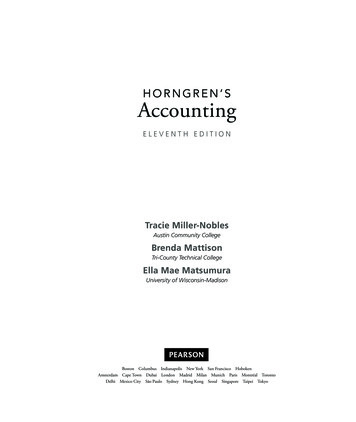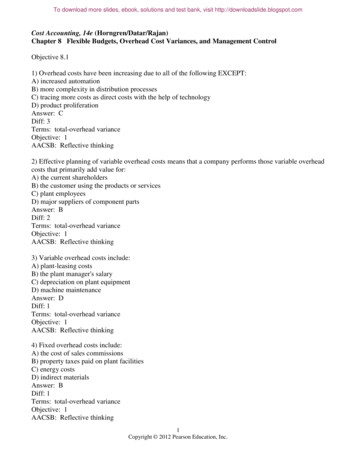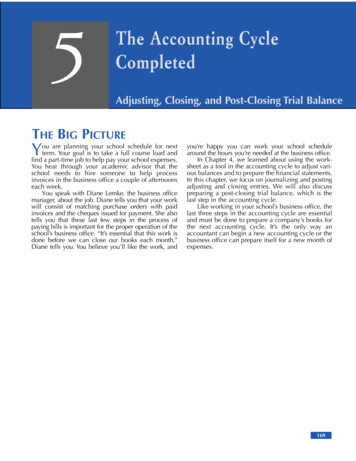
Transcription
Horngren’sAccountingELEVENTH editionTracie Miller-NoblesAustin Community CollegeBrenda MattisonTri-County Technical CollegeElla Mae MatsumuraUniversity of Wisconsin-MadisonBoston Columbus Indianapolis New York San Francisco HobokenAmsterdam Cape Town Dubai London Madrid Milan Munich Paris Montréal TorontoDelhi Mexico City São Paulo Sydney Hong Kong Seoul Singapore Taipei TokyoA01 NOBL6781 11 SE FM.indd 118/12/14 4:23 PM
Vice President, Business Publishing: Donna BattistaSenior Acquisitions Editor: Lacey VitettaEditorial Assistant: Christine DonovanVice President, Product Marketing: Maggie MoylanDirector of Marketing, Digital Services and Products: Jeanette KoskinasSenior Product Marketing Manager: Alison HaskinsExecutive Field Marketing Manager: Lori DeShazoSenior Strategic Marketing Manager: Erin GardnerTeam Lead, Program Management: Ashley SantoraProgram Manager: Mary Kate MurrayTeam Lead, Project Management: Jeff HolcombProject Manager: Roberta ShermanSupplements Project Manager: Andra SkaalrudOperations Specialist: Carol MelvilleCreative Director: Blair BrownArt Director: Jon BoylanVice President, Director of Digital Strategy and Assessment: Paul GentileManager of Learning Applications: Paul DelucaDigital Editor: Sarah PetersonDirector, Digital Studio: Sacha LaustsenDigital Studio Manager: Diane LombardoProduct Manager: James BatemanDigital Content Team Lead: Noel LotzDigital Content Project Lead: Martha LaChanceFull-Service Project Management and Composition:Integra Software Services Pvt. Ltd.Interior Designer: Jon BoylanCover Designer: Jon BoylanCover Art: Determined/FotoliaPrinter/Binder: R. R. DonnelleyCover Printer: Lehigh Phoenix Color/HagerstownTypeface: 11/13, Adobe Garamond Pro RegularMicrosoft and/or its respective suppliers make no representations about the suitability of the information contained in the documents and related graphicspublished as part of the services for any purpose. All such documents and related graphics are provided “as is” without warranty of any kind. Microsoft and/orits respective suppliers hereby disclaim all warranties and conditions with regard to this information, including all warranties and conditions of merchantability,whether express, implied or statutory, fitness for a particular purpose, title and non-infringement. In no event shall Microsoft and/or its respective suppliers beliable for any special, indirect or consequential damages or any damages whatsoever resulting from loss of use, data or profits, whether in an action of contract,negligence or other tortious action, arising out of or in connection with the use or performance of information available from the services.The documents and related graphics contained herein could include technical inaccuracies or typographical errors. Changes are periodically added to theinformation herein. Microsoft and/or its respective suppliers may make improvements and/or changes in the product(s) and/or the program(s) describedherein at any time. Partial screen shots may be viewed in full within the software version specified.Microsoft and Windows are registered trademarks of the Microsoft Corporation in the U.S.A. and other countries. This book is not sponsored orendorsed by or affiliated with the Microsoft Corporation.Copyright 2016, 2014, 2012, Pearson Education, Inc. or its affiliates. All Rights Reserved. Manufactured in the United States of America. This publication is protected by copyright, and permission should be obtained from the publisher prior to any prohibited reproduction, storage in a r etrieval s ystem,or transmission in any form or by any means, electronic, mechanical, photocopying, recording, or otherwise. For information r egarding permissions, requestforms, and the appropriate contacts within the Pearson Education Global Rights and Permissions department, please visit www.pearsoned.com/permissions/.Acknowledgments of third-party content appear on the appropriate page within the text or on pages P-1 and P-2, which constitutes an extension of thiscopyright page.PEARSON, ALWAYS LEARNING and MYACCOUNTINGLAB are exclusive trademarks owned by Pearson Education, Inc. or its affiliates in the U.S.and/or other countries, Inc. or its affiliates.Unless otherwise indicated herein, any third-party trademarks that may appear in this work are the property of their respective owners, and any referencesto third-party trademarks, logos, or other trade dress are for demonstrative or descriptive purposes only. Such references are not intended to imply anysponsorship, endorsement, authorization, or promotion of Pearson’s products by the owners of such marks, or any relationship between the owner andPearson Education, Inc. or its affiliates, authors, licensees, or distributors.Library of Congress Cataloging-in-Publication DataMiller-Nobles, Tracie L.Horngren’s accounting / Tracie Nobles, Texas State University, San Marcos, Brenda Mattison, Tri-County Technical College, Ella Mae Matsumura,University of Wisconsin/Madison.—Eleventh edition.pages cmISBN 978-0-13-385678-11. Accounting. I. Mattison, Brenda. II. Matsumura, Ella Mae, 1952– III. Title.HF5636.N63 2014b657—dc23201404380210 9 8 7 6 5 4 3 2 1ISBN-13: 978-0-13-385678-1ISBN-10: 0-13-385678-XA01 NOBL6781 11 SE FM.indd 218/12/14 4:23 PM
About the AuthorsTracie L. Miller-Nobles, CPA, received her bachelor’s and master’s degreesin accounting from Texas A&M University and is currently pursuing her Ph.D. in adult learning also at Texas A&M University. She is an Associate Professor at Austin Community College,Austin, TX. Previously she served as a Senior Lecturer at Texas State University, San Marcos,TX, and has served as department chair of the Accounting, Business, Computer InformationSystems, and Marketing/Management department at Aims Community College, Greeley,CO. In addition, Tracie has taught as an adjunct professor at University of Texas and has public accounting experience with Deloitte Tax LLP and Sample & Bailey, CPAs.Tracie is a recipient of the Texas Society of CPAs Rising Star Award, TSCPAsOutstanding Accounting Educator Award, NISOD Teaching Excellence Award and theAims Community College Excellence in Teaching Award. She is a member of the Teachersof Accounting at Two Year Colleges, the American Accounting Association, the AmericanInstitute of Certified Public Accountants, and the Texas State Society of Certified PublicAccountants. She is currently serving on the Board of Directors as secretary/ webmaster ofTeachers of Accounting at Two Year Colleges, as a member of the American Institute ofCertified Public Accountants nominations committee, and as chair of the Texas Society of CPAs Relations with Education Institutions committee. In addition, Tracie served on the Commission on Accounting Higher Education: Pathways to a Profession.Tracie has spoken on such topics as using technology in the classroom, motivating non-business majors to learn accounting, and incorporating activelearning in the classroom at numerous conferences. In her spare time she enjoys spending time with her friends and family and camping, kayaking, and quilting.Brenda L. Mattison has a bachelor’s degree in education and a master’s degree in account-ing, both from Clemson University. She is currently an Accounting Instructor at Tri-County TechnicalCollege in Pendleton, South Carolina. Brenda previously served as Accounting Program Coordinatorat TCTC and has prior experience teaching accounting at Robeson Community College, Lumberton,North Carolina; University of South Carolina Upstate, Spartanburg, South Carolina; and RasmussenBusiness College, Eagan, Minnesota. She also has accounting work experience in retail and manufacturing businesses.Brenda is a member of Teachers of Accounting at Two Year Colleges and the AmericanAccounting Association. She is currently serving on the board of directors as Vice President ofConference Administration of Teachers of Accounting at Two Year Colleges.Brenda previously served as Faculty Fellow at Tri-County Technical College. She has presentedat several conferences on topics including active learning, course development, and student engagement.In her spare time, Brenda enjoys reading and spending time with her family. She is also anactive volunteer in the community, serving her church and other organizations.Ella Mae Matsumura, Ph.D. is a professor in the Department of Accountingand Information Systems in the School of Business at the University of Wisconsin–Madison,and is affiliated with the university’s Center for Quick Response Manufacturing. She receivedan A.B. in mathematics from the University of California, Berkeley, and M.Sc. and Ph.D.degrees from the University of British Columbia. Ella Mae has won two teaching excellenceawards at the University of Wisconsin–Madison and was elected as a lifetime fellow of theuniversity’s Teaching Academy, formed to promote effective teaching. She is a member of theuniversity team awarded an IBM Total Quality Management Partnership grant to develop curriculum for total quality management education.Ella Mae was a co-winner of the 2010 Notable Contributions to ManagementAccounting Literature Award. She has served in numerous leadership positions in the AmericanAccounting Association (AAA). She was coeditor of Accounting Horizons and has chaired andserved on numerous AAA committees. She has been secretary-treasurer and p resident of theAAA’s Management Accounting Section. Her past and current research articles focus on decision making, performance evaluation, c ompensation, supplychain relationships, and sustainability. She coauthored a monograph on customer profitability analysis in credit unions.iiiA01 NOBL6781 11 SE FM.indd 318/12/14 4:23 PM
Brief ContentsChapter 1Accounting and the Business EnvironmentChapter 2Recording Business TransactionsChapter 3The Adjusting Process115Chapter 4Completing the Accounting Cycle181Chapter 5Merchandising Operations244Chapter 6Merchandise Inventory322Chapter 7Accounting Information Systems372Chapter 8Internal Control and Cash430Chapter 9Receivables479Chapter 10Plant Assets, Natural Resources, and Intangibles530Chapter 11Current Liabilities and Payroll579Chapter 12Partnerships620Chapter 13Corporations673Chapter 14Long-Term Liabilities728Chapter 15Investments777Chapter 16The Statement of Cash Flows809Chapter 17Financial Statement Analysis874Chapter 18Introduction to Managerial Accounting937Chapter 19Job Order Costing981Chapter 20Process Costing1033Chapter 21Cost-Volume-Profit Analysis1099Chapter 22Master Budgets1168Chapter 23Flexible Budgets and Standard Cost Systems1253Chapter 24Cost Allocation and Responsibility Accounting1311Chapter 25Short-Term Business Decisions1377Chapter 26Capital Investment Decisions1431153Appendix A—2013 Green Mountain Coffee Roasters, Inc. Annual ReportA-1Appendix B—Present Value TablesB-1GlossaryG-1IndexI-1Photo CreditsP-1ivA01 NOBL6781 11 SE FM.indd 418/12/14 4:23 PM
Contents1ChapterAccounting and the Business Environment 1Why Is Accounting Important? 2Decision Makers: The Users of Accounting Information 3The Accounting Profession 4What Are the Organizations and Rules That GovernAccounting? 6Governing Organizations 6Generally Accepted Accounting Principles 6The Economic Entity Assumption 6The Cost Principle 7The Going Concern Assumption 7The Monetary Unit Assumption 7International Financial Reporting Standards 8Ethics in Accounting and Business 8What Is the Accounting Equation? w Do You Analyze a Transaction? 11Transaction Analysis for Smart Touch Learning 11How Do You Prepare Financial Statements? 17Income Statement 17Statement of Owner’s Equity 18Balance Sheet 19Statement of Cash Flows 20How Do You Use Financial Statements to Evaluate BusinessPerformance? 22Green Mountain Coffee Roasters, Inc. 22Return on Assets (ROA) 22 Review 24 Assess Your Progress 29 Critical Thinking 512ChapterRecording Business Transactions 53What Is an Account? hart of Accounts 56Ledger 57What Is Double-Entry Accounting? 58The T-Account 58Increases and Decreases in the Accounts 58Expanding the Rules of Debit and Credit 59The Normal Balance of an Account 59Determining the Balance of a T-Account 60How Do You Record Transactions? 61Source Documents—The Origin of theTransactions 61Journalizing and Posting Transactions 62The Ledger Accounts After Posting 73The Four-Column Account: An Alternative to theT-Account 75A01 NOBL6781 11 SE FM.indd 5What Is the Trial Balance? 77Preparing Financial Statements from the Trial Balance 77Correcting Trial Balance Errors 78How Do You Use the Debt Ratio to Evaluate BusinessPerformance? 79 Review 81 Assess Your Progress 88 Critical Thinking 1133ChapterThe Adjusting Process 115What Is the Difference Between Cash Basis Accounting andAccrual Basis Accounting? 116What Concepts and Principles Apply to Accrual BasisAccounting? 118The Time Period Concept 118The Revenue Recognition Principle 118The Matching Principle 119What Are Adjusting Entries, and How Do We Record Them? 120Deferred Expenses 121Deferred Revenues 127Accrued Expenses 128Accrued Revenues 131What Is the Purpose of the Adjusted Trial Balance, andHow Do We Prepare It? 136What Is the Impact of Adjusting Entries on the FinancialStatements? 138How Could a Worksheet Help in Preparing Adjusting Entriesand the Adjusted Trial Balance? 139Appendix 3A: Alternative Treatment of Recording DeferredExpenses and Deferred Revenues 141What Is an Alternative Treatment of Recording DeferredExpenses and Deferred Revenues? 141Deferred Expenses 141Deferred Revenues 143 Review 144 Assess Your Progress 152 Critical Thinking 1784ChapterCompleting the Accounting Cycle 181How Do We Prepare Financial Statements? 182Relationships Among the Financial Statements 183How Could a Worksheet Help in Preparing FinancialStatements? 187Section 5—Income Statement 187Section 6—Balance Sheet 187Section 7—Determine Net Income or Net Loss 187What Is the Closing Process, and How Do We Close theAccounts? 189Closing Temporary Accounts—Net Income for the Period 191Closing Temporary Accounts—Net Loss for the Period 193v18/12/14 4:23 PM
How Do We Prepare a Post-Closing Trial Balance? 195What Is the Accounting Cycle? 197How Do We Use the Current Ratio to Evaluate BusinessPerformance? 198Appendix 4A: Reversing Entries: An Optional Step 200What Are Reversing Entries? 200Accounting for Accrued Expenses 200Accounting Without a Reversing Entry 201Accounting With a Reversing Entry 202 Review 204 Assess Your Progress 212 Comprehensive Problem 1 for Chapters 1–4 239 Comprehensive Problem 2 for Chapters 1–4 240 Critical Thinking 2415ChapterMerchandising Operations 244What Are Merchandising Operations? 245The Operating Cycle of a Merchandising Business 245Merchandise Inventory Systems: Perpetual and Periodic InventorySystems 247How Are Purchases of Merchandise Inventory Recordedin a Perpetual Inventory System? 248Purchase of Merchandise Inventory 249Purchase Discounts 250Purchase Returns and Allowances 251Transportation Costs 252Cost of Inventory Purchased 254How Are Sales of Merchandise Inventory Recordedin a Perpetual Inventory System? 255Sale of Merchandise Inventory 255Sales Discounts 257Sales Returns and Allowances 257Transportation Costs—Freight Out 259Net Sales Revenue and Gross Profit 259What Are the Adjusting and Closing Entries fora Merchandiser? 260Adjusting Merchandise Inventory Based on a Physical Count 260Closing the Accounts of a Merchandiser 261Worksheet for a Merchandising Business—Perpetual InventorySystem 263How Are a Merchandiser’s Financial StatementsPrepared? 264Income Statement 264Statement of Owner’s Equity and the Balance Sheet 267How Do We Use the Gross Profit Percentage to EvaluateBusiness Performance? 267 Review 279 Assess Your Progress 290 Comprehensive Problem for Chapters 1–5 318 Critical Thinking 3196ChapterMerchandise Inventory 322What Are the Accounting Principles and ControlsThat Relate to Merchandise Inventory? 323Accounting Principles 323Control Over Merchandise Inventory 324How Are Merchandise Inventory Costs DeterminedUnder a Perpetual Inventory System? 325Specific Identification Method 327First-In, First-Out (FIFO) Method 328Last-In, First-Out (LIFO) Method 329Weighted-Average Method 331How Are Financial Statements Affected by Using DifferentInventory Costing Methods? 334Income Statement 334Balance Sheet 335How Is Merchandise Inventory Valued When Usingthe Lower-of-Cost-or-Market Rule? 337Computing the Lower-of-Cost-or-Market 337Recording the Adjusting Journal Entry to Adjust MerchandiseInventory 337What Are the Effects of Merchandise Inventory Errorson the Financial Statements? 339How Do We Use Inventory Turnover and Days’ Sales inInventory to Evaluate Business Performance? 341Inventory Turnover 342Days’ Sales in Inventory 342Appendix 6A: Merchandise Inventory Costs Undera Periodic Inventory System 343How Are Merchandise Inventory Costs Determined Undera Periodic Inventory System? 343First-In, First-Out (FIFO) Method 344Last-In, First-Out (LIFO) Method 345Weighted-Average Method 345 Review 346 Assess Your Progress 353 Critical Thinking 3707ChapterAccounting Information Systems 372Appendix 5A: Accounting for Merchandise Inventoryin a Periodic Inventory System 269What Is an Accounting Information System? 373How Are Merchandise Inventory Transactions Recordedin a Periodic Inventory System? 269How Are Sales and Cash Receipts Recorded In a ManualAccounting Information System? 376Purchases of Merchandise Inventory 269Sale of Merchandise Inventory 271Adjusting and Closing Entries 271Preparing Financial Statements 274viEffective Accounting Information Systems 373Components of an Accounting Information System 374Special Journals 376Subsidiary Ledgers 377The Sales Journal 378The Cash Receipts Journal 381ContentsA01 NOBL6781 11 SE FM.indd 618/12/14 4:23 PM
How Are Purchases, Cash Payments, And Other TransactionsRecorded In a Manual Accounting Information System? 385The Purchases Journal 385The Cash Payments Journal 387The General Journal 390How Are Transactions Recorded In a ComputerizedAccounting Information System? 392Entry-Level Software 392Enterprise Resource Planning (ERP) Systems 392QuickBooks 393 Review 397 Assess Your Progress 402 Comprehensive Problems for Chapter 7 425 Critical Thinking 4278ChapterInternal Control and Cash 430What Is Internal Control, and How Can It Be Used to Protecta Company’s Assets? 431Internal Control and the Sarbanes-Oxley Act 431The Components of Internal Control 432Internal Control Procedures 433The Limitations of Internal Control—Costs and Benefits 435What Are the Internal Control Procedures With Respectto Cast Receipts? 436Cash Receipts Over the Counter 436Cash Receipts by Mail 437What Are the Internal Control Procedures With Respectto Cash Payments? 438Controls Over Payment by Check 438How Can a Petty Cash Fund Be Used for Internal ControlPurposes? 440Setting Up the Petty Cash Fund 441Replenishing the Petty Cash Fund 441Changing the Amount of the Petty Cash Fund 443How Can the Bank Account Be Used as a Control Device? 443Signature Card 444Deposit Ticket 444Check 444Bank Statement 445Electronic Funds Transfers 445Bank Reconciliation 446Examining a Bank Reconciliation 449Journalizing Transactions from the Bank Reconciliation 450How Can the Cash Ratio Be Used to Evaluate BusinessPerformance? 451 Review 452 Assess Your Progress 460 Critical Thinking 4779ChapterReceivables 479What Are Common Types of Receivables, and How Are CreditSales Recorded? 480Types of Receivables 480Exercising Internal Control Over Receivables 481
The Adjusting process 115 What Is the Difference Between Cash Basis Accounting and Accrual Basis Accounting? 116 What Concepts and Principles Apply to Accrual Basis Accounting? 118 The Time Period Concept 118 The Revenue Recognition Principle 118 The Matching Principle 119 What Are A











